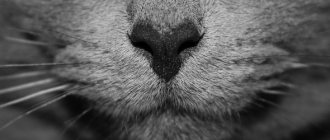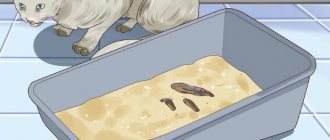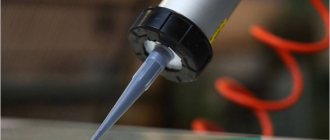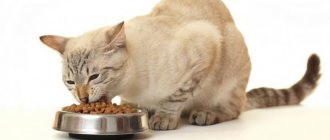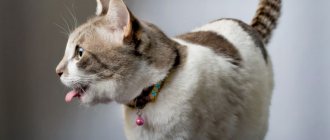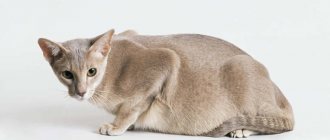A cat's nose is an indicator of well-being
A cat's nose primarily performs an olfactory function. There are an order of magnitude more receptors in it than in humans, so it greatly helps the animal navigate its environment. Thanks to him, even kittens immediately after birth are not as helpless as they might seem. Despite the fact that they have not only sight, but also hearing, they find their mother using their nose.
The nasal sinuses are separated by a cartilaginous septum, and behind them are the ethmoid conchae. If the smell falls into this section, then the receptors transmit it to the brain, and what the cat sniffed is correlated with previously remembered smells and is determined. If the cat is a flat-faced breed, then its nasal bones are deformed, which makes it harder for it to breathe, and it also does not recognize odors so well.
But the nose also has other functions - protective and tactile. The air inside it is cleaned of dust and microorganisms, and also warms up. The tactile function is performed thanks to the lobe - with its help, cats determine the temperature of food.
It is the lobe that makes it possible to monitor the well-being of your pet. A healthy person should have:
- cool,
- wet,
- shine slightly
- have no crusts or scales.
It becomes wet for a reason, but because the mucous membrane secretes a special secretion. Thanks to it, a protective film appears - it protects the cat from adverse influences and retains foreign substances to identify their odors. Another reason for a cat's nose to be wet is that the cat herself often licks it.
What kind of nose should a healthy pet have?
Many owners are concerned with the question of what a healthy kitten’s nose should be like. First of all, a healthy nose is a moist and cool nose that glides a little. This is due to the nature of the animal. In fact, cats are predators for whom the nose is the main assistant in the hunt. The wet organ helps determine where the wind is blowing - this is necessary so that the victim does not smell the cat's scent. This is why having a wet nose is important.
When determining the health of a pet, it is necessary to take into account the type of activity of the kitten. If he has just woken up or was engaged in active play, then he may experience a dry nose. This is due to the fact that pets have a higher body temperature than their owners, and therefore moisture evaporation occurs more intensely. Physiological causes of dryness are:
- dream; awakening; active games; hot room; sharp fear; prolonged exposure to the sun; sedentary lifestyle.
What causes your nose to become dry and warm?
A warm nose has a very simple explanation - it is associated with increased body temperature, as well as blood pressure. But this does not necessarily mean that the cat is sick - an increase in temperature can be caused by other reasons.
When the animal is normal
If we are talking about a kitten, then the matter may simply be that he does not know how to take care of his nose, because his mother used to do it. If they were separated early, this situation is quite possible, and if the kitten has a warm nose, then the owner needs to take care of moisturizing it, otherwise the nose may crack and hurt.
If a cat has a warm nose, but otherwise looks healthy - is active, has a good appetite, then the reasons may be:
- Excessive activity. With intense muscle work, the metabolism accelerates, resulting in rapid fluid loss and an increase in temperature.
- Sleeping too long. Processes in the animal's body slow down when it sleeps, and this also applies to the work of the mucous glands. Therefore, after waking up, the nose may be dry and quickly warm up - over time it will return to normal.
- The pet drinks little. It is worth making sure that he has enough fluid, because a lack of it can lead to dehydration.
- The room is too warm and dry. If moisture evaporates faster than secretions are produced, the cat's nose becomes dry. To prevent this from happening, it is better to keep pets away from heating appliances. An air humidifier also helps - in general, if a cat’s nose is dry due to the atmosphere in the room, then it is also unfavorable for people, so a humidifier will be useful for everyone.
- Stress. If a cat is worried, this is reflected in a change in its behavior; it can become aggressive, avoid people and other animals, and lick itself frequently. Stress can be caused by moving or a new occupant of the house - then it will pass over time. If the reason is different, it is worth eliminating it if possible, and sometimes using sedatives so that the pet does not remain depressed for too long.
- Estrus. Its onset can be determined by the behavior of the animal - this is usually not difficult to do.
When determining body temperature from the earlobe, you can only rely on sensations, which does not ensure accuracy. If the nose does not return to normal for a long time, it is worth measuring its body temperature using a rectal thermometer.
Normal condition of a cat's nose
If the animal is in good health, its nose will be wet and slightly slippery. This physiological state is explained by the fact that cats regularly lick their tongues, releasing a specific secretion that plays the role of protection.
- A cat’s nose is not only an organ for smell perception, but also an “indicator”. With the help of this important organ for detecting scents or “hide” from the victim, he can easily scout the temperature of nearby objects and the direction of the air mass.
- Don't panic if your little animal sometimes has a warm, dry nose. This is a normal phenomenon and is explained by the fact that kittens have not yet learned to maintain hygiene, and the cells of the mucous membrane do not produce enough secretions.
In this case, the little “whiskers” hope for the help of their mother cat. If they are separated from their mother too early, then all responsibility in this regard falls on the shoulders of the owner.
Dangerous causes of warm and dry nose
If none of the previously listed reasons apply, a warm nose may indicate an illness in your pet. You can roughly determine it by the symptoms, although you should consult a doctor to make an accurate diagnosis.
Fever is one of the symptoms of the following diseases:
- neoplasms in the nasal sinuses, or something may simply get stuck in them;
- injuries due to which secretion production decreases or stops;
- rhinitis, sinusitis;
- various types of inflammation and infectious diseases;
- diseases of the urinary system;
- gastrointestinal upset due to overeating;
- poisoning;
- trichobezoars in the stomach or intestines;
- tick infestation.
If you suspect that the cause of a warm nose is something from this list, you should show your pet to a doctor. The sooner the disease can be identified and treatment begun, the lower the likelihood of complications.
In what cases should you immediately contact the clinic?
Here are the cases in which you need to immediately contact the clinic:
- The animal is apathetic and does not react to anything.
- The kitten refuses food and water (refusing to drink is the worst).
- The baby is very chilly and has a lot of snot.
- Severe cough and other accompanying signs of infectious diseases of the upper respiratory tract.
- When breathing is accompanied by strong, heavy wheezing.
- Sunken eyeballs, a cold nose and limbs, as well as sagging skin are signs of fatal dehydration; you need to take your kitten to the doctor immediately!
What signs may accompany a dry and warm nose?
You can guess the reasons for changes in the condition of the nose by the accompanying signs. If any of them indicate pathology, you should immediately consult a doctor. Let's list the main features.
Loss of appetite
Usually indicates that the pet is weakened. If he has a disease of internal organs, inflammation, or has caught an infection, then in addition to low appetite, this will be indicated by apathy, prolonged sleep and high temperature.
If the temperature is normal, it is worth remembering whether there has been anything recently that could cause stress in the cat. If this is the reason, the pet should be surrounded with attention, and it will quickly return to normal.
Ears too warm
If not only the nose is hot, but the ears too, then the cat has hyperthermia. The reason may be:
- colds or otitis media;
- trauma, hematoma;
- viral infection;
- stress;
- staying in a room that is too warm and stuffy for a long time.
Some of these reasons can be eliminated on your own, but in some cases you will have to go to the doctor.
Nose changed color
If the nose has acquired a bluish tint, this may be a sign of intoxication, yellow - kidney failure, redness indicates a burn, and pallor - a heart pathology.
Other symptoms
If the cause is a viral infection or damage to the gastrointestinal tract, vomiting and diarrhea are possible. If blood is visible in the vomit or stool, you should consult a doctor immediately, because this indicates damage to internal organs.
You can also determine something by the color of nasal discharge: it can be transparent, contain pus or sulfur. If your cat has a cold, its eyes may become red and breathing may become difficult. When infested with parasites, the quality of the coat deteriorates and it begins to fall out.
If the animal suddenly loses weight, has anemia, difficulty breathing, convulsions and paralysis, the cause may be a malignant neoplasm. A wobbly gait and increased salivation should also be a reason to consult a doctor because it indicates damage to the nervous system - its consequences can be very serious.
Normal or abnormal
A healthy animal's nose is cool and moist.
The nasal planum contains many glands that secrete fluid that covers the sensitive areas of the earlobe. Due to the evaporation of water, the temperature of the nose decreases, it becomes cool.
When you shouldn't worry
A hot or cold nose that is dry is not always dangerous. There are many reasons that provoke such changes. You need to take a closer look at your pet.
For example, if dryness is observed, but an active cat continues to eat with appetite, plays with pleasure, and leads a normal lifestyle, there is no need to worry.
Warning signs
If you notice not only a dry and warm nose, but also weakness and other negative changes, you should not postpone a visit to the doctor.
The following signs should not be ignored:
apathy and general malaise;- pallor of the organ of smell;
- change in the color of the mirror (blueness, yellowness, redness, white tint);
- frequent or slow breathing (normally, the pet should take 16-33 breaths per minute);
- acceleration of heartbeat. A healthy pet has 100–120 beats per minute;
- sneezing or coughing;
- convulsions;
- hot ears;
- loss of appetite;
- presence of blood in stool or urine;
- lack of response to stimuli;
- rise in body temperature;
- the presence of mucous or purulent discharge from the olfactory organ;
- vomit;
- diarrhea or constipation;
- foam from the mouth;
tearfulness;- the abdomen becomes hard, painful sensations are observed in this area;
- strong thirst;
- refusal to drink;
- deterioration of coat condition;
- sleep disturbance;
- unsteadiness of gait;
- rash on the skin;
- excessive activity, irritability.
Excessively wet nose
It also happens that the nose is too wet - this can also indicate health problems. Causes of increased nasal moisture include:
- Cold - the earlobe does not dry out due to a runny nose and sneezing.
- Allergies can also be accompanied by a runny nose and sneezing.
- Hypothermia and poisoning can cause a drop in temperature, accompanied by increased moisture in the nose.
- Infections – sometimes they are characterized by a combination of a too wet nose and hot ears.
- Diseases of the heart and blood vessels - this is indicated by too pale mucous membranes.
- Polyps or foreign objects, as well as tumors. Because of them, mucus production may increase.
There are many options, so trying to cure your pet yourself is undesirable and even dangerous. If the cause is determined incorrectly, time will be lost and the animal’s condition will only get worse.
Pathological causes of fever in a cat
A pet's dry, hot nose for several hours may indicate illness. It is necessary to carefully examine the animal to try to determine the cause of the illness.
Examination of mucous membranes
Changing the color of the nasal mirror, like other mucous membranes, can help in determining the area of pathology. It occurs in the following cases:
- increased pallor appears with hypothermia and poisoning, and it also appears with anemia - a lack of hemoglobin in the blood;
- cyanosis of the skin and mucous membranes occurs when there is a lack of oxygen in the tissues, which may indicate a malfunction of the cardiovascular system;
- a reddish tint to the nose indicates an infectious disease, including rhinitis, and this color is also possible with high blood pressure, allergies or injury;
- a yellowish color appears in case of liver problems.
Diagnosis of changes in the color of mucous membranes is easy to carry out if the nose mirror is light, and black cats will have to examine the inside surface of the mouth.
The pale mucous membrane of the oral cavity may look like this
By examining the mucous membrane of the mouth, you can check the functioning of the circulatory system. To do this, you need to press on the surface and then release. The white spot that appears when pressed should disappear within 2 - 3 s. If this does not happen, there are problems in its functioning.
Pulse detection
Pulse is an essential indicator of health status. To calculate it, you need a stopwatch or a watch with a second hand. In cats, the pulse is best felt in the femoral artery, which is located on the inside of the limb. To find it, you can follow the suggested instructions:
- lightly press with your fingers at the point where the artery passes to feel the pulsation of the blood flow;
- note the time on the stopwatch, and within 10 s. count blood pulses;
- multiply the resulting result by 6, this will be the pulse rate - the number of beats per minute.
A cat's normal heart rate is between 120 and 140 beats/min. But in large breeds of cats it is a little slower, and in small kittens it can reach 190 beats per minute.
Hand position when determining a cat's pulse
The pulse changes in the following cases:
- with an increase in body temperature, emotional arousal, during the period of searching for a mate, the pulse increases;
- inflammation of the heart muscle (myocarditis) can cause both a slower and faster heart rate;
- Poisoning at the initial stage causes a strong heartbeat, and then the pulse drops below normal.
Temperature detection
An important indicator of a cat's health is body temperature. The most reliable indicators include the rectal method of measuring it (in the anus). An ordinary thermometer is suitable as a measuring device, but the duration of the procedure depends on its type:
- 6 minutes is required when using a mercury thermometer;
- 3 min - for its universal electronic analogue;
- 10 s - when using special rectal thermometers.
An electronic thermometer is also safer, since there is always the possibility of damage to the mercury flask and poisoning by its contents.
How to measure a cat's temperature
It is better to carry out the measurement procedure with an assistant to make it easier to hold the animal:
- prepare the thermometer by lubricating its tip with Vaseline or another emollient;
- secure the cat on a hard surface (or wrap it in a towel and hold it under your arm);
- the thermometer is slowly inserted into the anus about 2.5 cm;
- performing calming movements, you need to keep the cat in a motionless position for the required period of time;
- evaluate the measurement result, disinfect the thermometer and place it in your pet’s first aid kit.
The normal temperature of a healthy cat is 38.5°C. The following indicators are dangerous:
- below 37.8°C - such indicators can be due to hypothermia, problems with the endocrine system or bleeding;
- 39.2 - 39.5°C - high temperature, indicating the presence of pathology;
- over 41°C - a state of heat stroke, you must urgently contact a veterinarian and take measures to reduce the temperature before the doctor arrives: place the animal in a cool place;
- provide a flow of fresh air;
- apply ice;
- wash with cold water or, as a last resort, immerse the pet in it completely.
Actions to take if you suspect your pet is sick
You can try to reduce the temperature in the following ways:
- ventilate the room
- wet the wool with water,
- apply cold compresses to the armpits.
It is important to avoid dehydration. If the cat does not drink, it should be given water through a pipette or syringe. If crusts have formed on the lobe, use chlorhexidine or furatsilin to soak them. If your pet's condition does not improve, you should seek help from a doctor.
Antipyretics should not be given to cats unless prescribed by a doctor. Many drugs intended for humans are toxic to cats; their use will result in allergies or even poisoning, and if the animal is already sick, its condition can greatly worsen.
But you shouldn’t panic as soon as you discover that your cat has a dry and warm nose. First, just watch her, if there are no other signs of illness, perhaps everything will soon return to normal. But if you notice them, you should not hesitate to consult a doctor.
When should you sound the alarm?
If you notice that the earlobe is hot and dry, then you should pay attention to the accompanying symptoms:
- formation of crusts on the nose;
- mucous discharge from the nasal septum;
- lethargic state of the pet;
- swollen jaw;
- drowsiness;
- hair falls out all over the body;
- lack of appetite;
- sores on the face;
- strange reaction to external stimuli;
- does not drink water for a long time;
- gagging;
- diarrhea;
- unusual behavior.
We recommend the article: The cat has bumps all over its body: causes, consequences.
A kitten has a dry nose due to the development of inflammatory, infectious and other diseases inside the body. At the same time, the ears also become warm and additional symptoms appear, such as shortness of breath, fever or rapid pulse. If several symptoms appear at once, then most likely the disease has spread throughout the body - it is necessary to urgently take the cat to a veterinary clinic.
You cannot use human medicines that reduce the temperature, as this will worsen the cat’s well-being and pose a risk to life.
